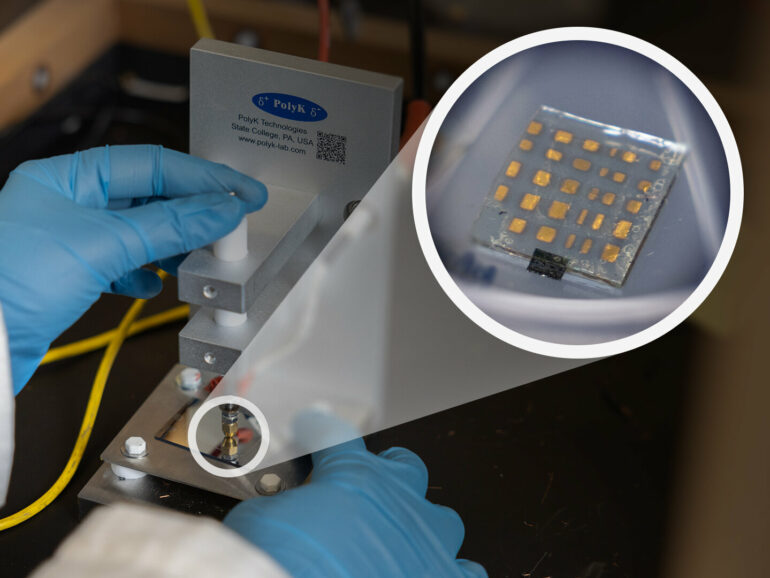In the quest for more efficient and sustainable energy solutions, a multi-university research team has reached a significant milestone in capacitor technology. Researchers from the University of Houston, Jackson State University and Howard University have developed a new type of flexible high-energy-density capacitor, which is a device that stores energy.
Though the prototype device is just 1-inch by 1-inch, scaled-up versions of this innovation could potentially revolutionize energy storage systems across various industries, including medical, aviation, auto (EV), consumer electronics and defense.
The researchers shared the study details in a paper titled “Ultrahigh Capacitive Energy Density in Stratified 2D Nanofiller-Based Polymer Dielectric Films,” published in the journal ACS Nano.
Dielectric capacitors, critical components of electronic devices and energy storage systems, are known for their ability to discharge high amounts of energy quickly, making them crucial for high-power applications.
“High-energy and high-power capacitors are essential for a reliable power supply, especially as we shift to using more renewable energy sources. However, current dielectric capacitors don’t store as much energy as other types of energy storage devices such as batteries. The higher power density of capacitors makes them more attractive for a multitude of applications as compared to batteries,” said Alamgir Karim, Dow Chair and Welch Foundation Professor of Chemical Engineering at UH and faculty mentor on the team.
The amount of energy a capacitor can store depends on its permittivity (ε) and dielectric breakdown strength (EBD). “To increase a capacitor’s energy storage, we need to improve both,” he added.
In this study, the researchers designed a new type of capacitor using layered polymers with oriented 2D nanofillers. They used mechanically exfoliated flakes of 2D materials as nanofillers. The researchers maximized energy storage by arranging these materials in specific layers, creating a sandwich-like structure to improve capacitor performance. The resulting sandwich is ultra-thin, thinner than human hair. This new design showed improved performance with higher energy density and efficiency than capacitors with randomly blended-in nanofillers.
“Our work demonstrates the development of high energy and high-power density capacitors by blocking electrical breakdown pathways in polymeric materials using the oriented 2D nanofillers,” said Maninderjeet Singh, who earned a Ph.D. in chemical engineering at UH last year and is the first author on the paper along with Priyanka Das from Jackson State University. “We achieved an ultra-high energy density of approximately 75 J/cm³, the highest reported for a polymeric dielectric capacitor to date.”
The research team utilized materials like mica and hexagonal boron nitride (hBN) to demonstrate the effectiveness of controlling 2D nanosheet orientation in blocking electrical breakdown pathways. Surprisingly, significant enhancements in dielectric permittivity were observed even with a minimal volume fraction (1%) of nanofillers.
“With the help of mechanical exfoliation and transfer techniques, we successfully achieved the desired orientation,” Karim said, adding that Jackson State researchers were critical to this part of the process. Both Karim and Nihar Pradhan from Jackson State are corresponding authors on the paper.
Given that the researchers demonstrated the first-of-its-kind use of stratified multilayered nanocomposites for the design of polymeric energy storage devices, Karim and Professor Dharmaraj Raghavan from Howard University, a nanocomposite expert expect these hybrid capacitors to be used in a broad range of applications in the future and plan to keep working to extend the energy storage capabilities by developing continuous organic-inorganic interfaces in such nanocomposites.
The potential applications of these high-energy-density capacitors are many. The researchers envision the capacitors eventually being used in medical devices like pacemakers and defibrillators, as well as applications in electronics, electric vehicles, power systems, and more.
“This research provides valuable insights into dielectric breakdown and charge polarization phenomena in 2D polymer nanocomposites,” said Singh, who is now a postdoctoral research scientist at Columbia University. “We believe that our findings will inspire further studies to develop even higher energy-density capacitors, contributing to a cleaner and more sustainable future.”
In addition to this breakthrough, the team has been researching other polymeric systems, including polymer topology manipulation, polymer grafted nanoparticles, and layered block copolymers in their quest for developing high energy density capacitors for a clean future.
More information:
Maninderjeet Singh et al, Ultrahigh Capacitive Energy Density in Stratified 2D Nanofiller-Based Polymer Dielectric Films, ACS Nano (2023). DOI: 10.1021/acsnano.3c06249
Provided by
University of Houston
Citation:
High-energy-density capacitors with 2D nanomaterials could significantly enhance energy storage (2024, April 24)
